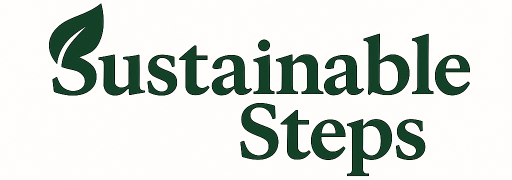Introduction
With growing concerns about climate change, pollution, and resource depletion, many people are asking the same question:
“What can I do to live more sustainably — starting at home?”
The good news is: you don’t need to overhaul your entire lifestyle overnight to make a real difference. Small, practical steps add up quickly. And when multiplied across households, these simple actions create meaningful environmental impact.

In this guide, we’ll explore the first, most effective steps you can take to start living more sustainably at home, without sacrificing comfort or breaking the bank.
Why Start at Home?
Our homes are where many of our largest environmental footprints occur:
- Energy consumption
- Water use
- Food waste
- Plastic use
- Transportation habits
By making smarter daily choices, you can reduce your household’s carbon footprint, save money, and promote healthier living — all while contributing to a more sustainable future.
First Step 1: Conduct a Home Sustainability Audit
Before making changes, assess your current habits.
Quick areas to review:
- How much energy do you use monthly?
- How much waste do you produce?
- How much water do you consume?
- How often do you drive vs. walk, bike, or use public transit?
- How much plastic packaging do you bring home weekly?
Why this matters:
Awareness helps you prioritise the areas with the biggest impact first.
First Step 2: Reduce Energy Consumption
Energy efficiency is one of the most immediate ways to cut your carbon footprint.
Easy changes:
- Switch to LED light bulbs
- Unplug devices when not in use
- Use smart power strips
- Turn off lights and appliances when leaving rooms
- Wash clothes in cold water
- Use ceiling fans to reduce air conditioning reliance
Bigger investments:
- Install a programmable thermostat
- Upgrade insulation and windows
- Transition to solar panels if possible
Bonus: Lower energy bills while reducing emissions.
First Step 3: Cut Down on Single-Use Plastics
Plastic pollution is one of the most visible environmental challenges.

Simple swaps:
- Use reusable shopping bags
- Switch to stainless steel or glass water bottles
- Avoid individually packaged snacks
- Use beeswax wraps instead of plastic cling film
- Choose refillable cleaning products
Tip:
Start with one room at a time — e.g., focus on reducing kitchen plastic first.
First Step 4: Start Composting
Food scraps and yard waste make up a large portion of landfill waste.
Benefits of composting:
- Reduces methane emissions from landfills
- Creates nutrient-rich soil for gardens
- Lowers your trash output
You can compost:
- Fruit and vegetable scraps
- Coffee grounds
- Eggshells
- Yard clippings
- Shredded newspaper
Options: Use a backyard compost bin, a worm farm, or check if your local council offers food waste collection.
First Step 5: Use Water Wisely
Freshwater is a precious, often overlooked resource.
Water-saving habits:
- Install low-flow showerheads and faucets
- Fix leaky taps promptly
- Collect rainwater for garden use
- Run dishwashers and washing machines only with full loads
- Use drought-resistant plants in landscaping
Small changes can reduce water bills and conserve vital resources.
First Step 6: Make Sustainable Food Choices
Your diet has a direct environmental impact.
Start with:
- Buy local and seasonal produce
- Reduce meat consumption (even one meatless day per week helps)
- Support farmers’ markets
- Grow herbs or vegetables at home
- Avoid food waste by meal planning and proper storage
Tip:
Eating sustainably doesn’t mean giving up your favorite foods — it means being mindful about your sources and portions.
First Step 7: Rethink Transportation
Transportation is one of the largest sources of personal emissions.

Actionable steps:
- Walk, bike, or carpool when possible
- Use public transportation
- Combine errands into fewer trips
- Drive fuel-efficient or hybrid vehicles
- Explore work-from-home options to reduce commuting
First Step 8: Buy Less, Choose Better
Consumer habits drive demand for energy, resources, and manufacturing.
Smart purchasing habits:
- Buy durable, high-quality items that last
- Choose second-hand or refurbished goods
- Avoid fast fashion
- Repair instead of replace when possible
- Borrow or rent infrequently used items
Less consumption = less waste = lower footprint.
First Step 9: Educate and Involve the Household
Sustainability works best when it’s a shared value at home.
- Involve kids in recycling and composting
- Create household sustainability challenges
- Track energy and water savings as a family
- Discuss why these changes matter
Collective action builds long-term habits.
First Step 10: Set Realistic, Incremental Goals
Don’t aim for perfection overnight. Set small, achievable targets like:

- Reducing energy use by 10% over 6 months
- Cutting single-use plastic by 50% this year
- Composting all food scraps within 3 months
Sustainable change is about consistency, not instant transformation.
Conclusion
Living more sustainably at home starts with small, intentional changes. Each step — from energy efficiency to food choices — builds momentum toward a healthier planet and a more mindful lifestyle.
The key is to start.
By taking the first steps today, you set the foundation for long-term habits that benefit both your family and the environment for years to come.
